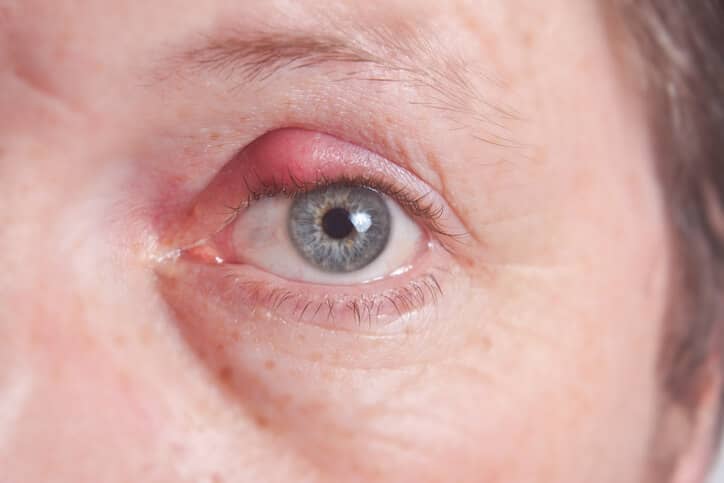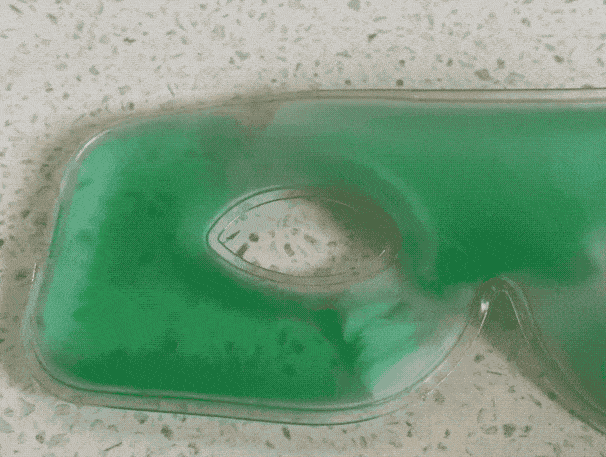Written and Medically Reviewed by Dr Leigh Plowman, Optometrist (updated Sept 2022)

Warm compresses are a longtime home remedy for many ailments and have been used by doctors to manage certain conditions.
For the eyes, warm compresses can help soothe irritation, improve circulation, and unclog your eyelid oil glands.
So how do you use a warm compress for eyes? Learn more about warm compresses and how to make one:
What Are Warm Compresses?
A warm compress is a traditional home remedy that can assist with many mild health issues. They are often recommended by medical professionals and doctors to help manage certain conditions.
Compresses traditionally use a clean washcloth soaked in warm water. Make sure it is not hot! Then, the wet cloth is applied to the skin or wound and compressed or held there for a specific period.
When you bring moisture and heat to the area, it helps to relieve inflammation, pain, and discomfort. Warm compresses can help with mild eye conditions, such as itchiness, styes, red-eye and dry eyes.
How to Use a Warm Eye Compress
Using a warm compress for your eyes is easy. Soak a clean cloth in warm water and apply it to your eye, making sure the eye is closed first. Apply it to both eyes simultaneously or one at a time if your cloth is small.
Hold the compress there for as long as you need so that it improves the symptoms and provides comfort.
Benefits of Warm Compress for Eyes
A warm compress is very soothing and can give you relief quickly. They can:
- Ease sore eyes – Compresses can ease a gritty/itchy feeling that comes from dry eye syndrome.
- Help to loosen debris in your oil glands – The glands in the eyelids produce oil. Sometimes, though, it gets clogged. The heat from the moisture thins the oil and helps it drain.
- Reduce muscle spasms and discomfort – Warmth helps your eye muscles to feel relaxed, reducing discomfort from muscle spasms
When to Use Warm Eye Compresses
Here are the times you can use a warm compress:
Styes
Warm compresses are a common treatment for styes. Sometimes, they’re called hordeola. They occur when a part of your eyelid gets swollen from an infection of an oil gland.
Chalazia occur due to blockage and inflammation of an oil gland. A compress is a common approach to relief and can soften blockages and help improve drainage. Intense Pulsed Light can also help treat chalazia.
Blepharitis
Inflammation of the eyelids is called Blepharitis. Compresses have been shown to help relieve soreness or irritation. Debris on the eyelids can also cause Blepharitis. Using eyelid wash or cleansers such as hypochlorous acid or okra-based products can help.
Swollen Eyes
As opposed to warm compresses, cold compresses can help your eyes feel better for swollen eyes. Causes for a swollen eye could include:
- Allergies
- Injuries (e.g. foreign body in the eye)
- Bug bites and stings
- Preorbital cellulitis
Less common causes can include Graves’ disease. With any of those conditions, you can apply a cold compress and get relief from the symptoms. However, a compress is not a proven cure, and you should talk to a healthcare professional about other treatments.
Dry Eye
Warm compresses can help with dry eyes. The heat of the compress helps the natural oils to flow better and produce better quality tears. This way, they work better.
You might find that after a warm compress that your vision is clearer. That is, less filmy, smeary or blurry.
Typically, compresses are common for dry eye syndrome, which includes Meibomian Gland Dysfunction. They provide relief and should be part of your daily eye routine. However, warm compresses don’t cure dry eye syndrome.
How often should you do them? Twice daily for best results. However, if you can only do one per day, that’s ok.
Pink Eye
Using a cold compress could also be helpful for pink eye, which is a common eye inflammation issue. Conjunctivitis means that the inner conjunctiva of the eye has swollen. It’s often caused by a virus, allergy, or bacteria.
Ultimately, cold compresses help with the itchiness, pain, inflammation, and discharge, but it doesn’t cure the underlying cause.
You should see your doctor to get a diagnosis. It’s better to know for sure when your health is on the line.
Black Eye
A black eye (periorbital hematoma) happens when there’s trauma to the eye. It often causes bruising, pain, discoloration around the eye, inflammation, and subcutaneous (underneath the skin) bleeding.
Ultimately, a cool compress can help with the pain you feel from a black eye. Generally, it’s recommended as a first-aid option and should be used after the primary swelling is gone.
Before using a compress for a black eye, talk to your doctor to find out if it’s appropriate.
What if I shower instead of using a warm compress?
Showering in the warm water feels great. However, moisture around your eyes can quickly cool. This reduces the temperature of your eyelids quickly. In other words, you don’t get the benefit of sustained warmth.
What if you shower with the water on your face for at least ten minutes? Warm water can deplete your skin of natural oils. You may end up with dry, flaky skin around your face.
Warm compress for eyes are best done away from the shower.
Making a Warm Compress at Home
You can make a warm compress at home. To begin, you should warm water in a pot on the stovetop. If your tap water is hot enough, you can get the warm water straight from the tap.
Alternatively, it might be easier to put the water in a bowl and microwave it for a few minutes. Just make sure that the temperature is warm and not hot because you don’t want to burn yourself.
In most cases, a microwave can be good choice if you’re in a hurry. Just check the temperature carefully before you apply it to the skin.
Now, you should soak a clean washcloth in the water. Dip it directly into the bowl or pot.
Most doctors recommend that you get the water between warm and hot, but it’s best to go with a temperature that is comfortable for you since you’re the one getting treatment.
Make sure that the water isn’t too warm because you have sensitive skin in that area!
Then, you apply the compress to the eye as described earlier. If you only need it for one eye, you may fold a large cloth in half.
But there’s a significant limitation of warm compresses
Warm compresses at home are convenient. However, heat in a washcloth or towel quickly dissipates. Within one or two minutes, the warmth is significantly reduced according to this study.
Getting up to reheat a warm compress every one-to-two minutes is a hassle. By the time you sat down, you’d have to get back up and reheat again.
Without enough heat, the warm compress falls below therapeutic levels. This means that it is not helping your eyes.
According to a major international committee, dry heat is better at helping dry eyes than moist heat.
What about warm compresses in the microwave?
Microwaveable warm compresses have been used in the past.
You may have been told by someone to fill an old sock with rice and heat it in the microwave.
However, our skin has a lot of bacteria, sometimes demodex mites, and other debris. Microwaveable masks are not made to be washed after each use.
Who wants to spend the time to empty the mask contents, wash it, and then tip it back in everyday?
What about using some material in the mask? You might try this, but how confident do you feel that debris isn’t getting through into the mask?
Each time you use these masks, you’re adding more bacteria and debris to your eyelids and eyes. They may even be making your eyes feel worse rather than better.
Are electric masks worth it?
Electric masks rely on plugging in each time you use them.
However, they can tend to put excessive pressure on your eyes and eyelids during use.
Manufacturers often talk about cleaning with a damp cloth. However, cleaning this way is not going to remove bacteria or debris in the mask.
You might be surprised what is really living in your mask.

A new warm compress device lets you do a warm eye compress with your eyes open. It’s easily portable and doesn’t need to be plugged in.
This compress is reactivated by boiling water. The sodium acetate crystals change to a gel-like form. Once reactivated, it can be used anytime. Simply click it and it activates and warms.
The great thing is that you’re cleaning the mask after each use. So you’re not re-adding bacteria or debris onto your eyelids.
As a doctor, I personally use this warm compress. I like to use two in a row.
You can order the device at this website
Conclusion
Warm compresses are a widely accepted home treatment for various mild eye conditions, such as dry eye disease. It’s crucial that you visit an eye doctor to get a diagnosis.
Warm compresses can help you to feel relief at home. When done every day, they help your oil glands to work better.
Another useful warm compress is Blephasteam. This device is like humidity goggles. It allows you to keep your eyes open during treatment. Learn more here.

